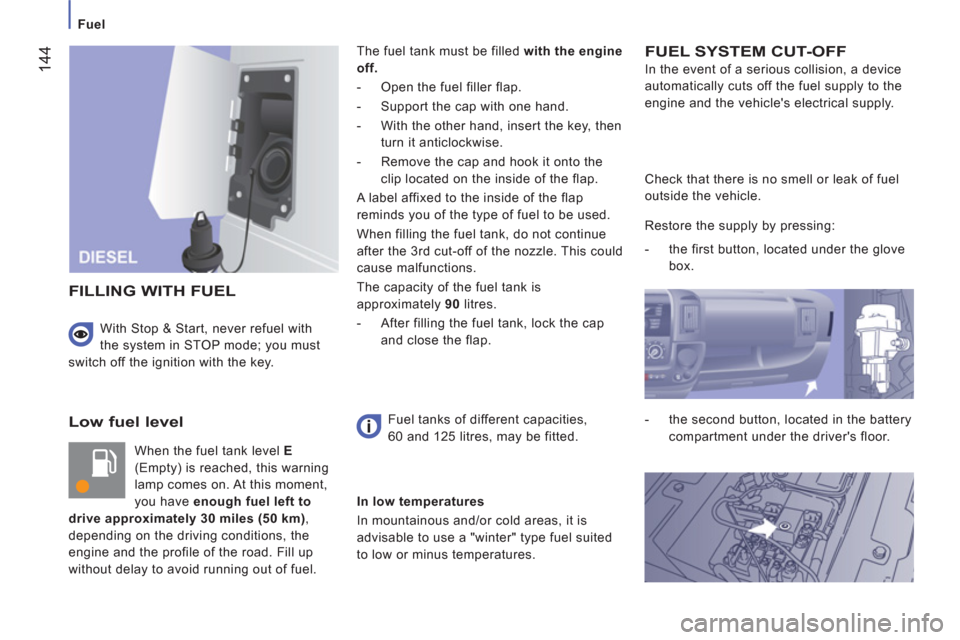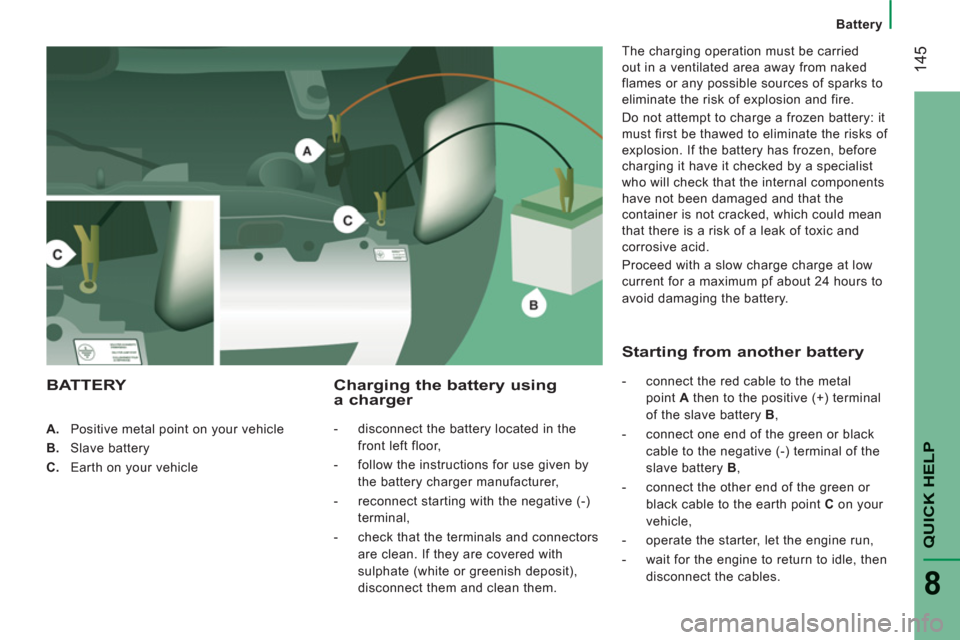Page 146 of 184

Fuel
144
Low fuel level
When the fuel tank level E
(Empty) is reached, this warning
lamp comes on. At this moment,
you have enough fuel left to
drive approximately 30 miles (50 km)
,
depending on the driving conditions, the
engine and the profile of the road. Fill up
without delay to avoid running out of fuel. The fuel tank must be filled with the engine
off.
- Open the fuel filler flap.
- Support the cap with one hand.
- With the other hand, insert the key, then
turn it anticlockwise.
- Remove the cap and hook it onto the
clip located on the inside of the flap.
A label affixed to the inside of the flap
reminds you of the type of fuel to be used.
When filling the fuel tank, do not continue
after the 3rd cut-off of the nozzle. This could
cause malfunctions.
The capacity of the fuel tank is
approximately 90
litres.
- After filling the fuel tank, lock the cap
and close the flap.
FUEL SYSTEM CUT-OFF
In the event of a serious collision, a device
automatically cuts off the fuel supply to the
engine and the vehicle's electrical supply.
FILLING WITH FUEL
Fuel tanks of different capacities,
60 and 125 litres, may be fitted. Check that there is no smell or leak of fuel
outside the vehicle.
Restore the supply by pressing:
- the first button, located under the glove
box.
- the second button, located in the battery
compartment under the driver's floor.
In low temperatures
In mountainous and/or cold areas, it is
advisable to use a "winter" type fuel suited
to low or minus temperatures.
With Stop & Start, never refuel with
the system in STOP mode; you must
switch off the ignition with the key.
Page 147 of 184

14
5
Battery
QUICK HELP
8
A.
Positive metal point on your vehicle
B.
Slave battery
C.
Earth on your vehicle
Charging the battery using a charger
- disconnect the battery located in the
front left floor,
- follow the instructions for use given by
the battery charger manufacturer,
- reconnect starting with the negative (-)
terminal,
- check that the terminals and connectors
are clean. If they are covered with
sulphate (white or greenish deposit),
disconnect them and clean them.
The charging operation must be carried
out in a ventilated area away from naked
flames or any possible sources of sparks to
eliminate the risk of explosion and fire.
Do not attempt to charge a frozen battery: it
must first be thawed to eliminate the risks of
explosion. If the battery has frozen, before
charging it have it checked by a specialist
who will check that the internal components
have not been damaged and that the
container is not cracked, which could mean
that there is a risk of a leak of toxic and
corrosive acid.
Proceed with a slow charge charge at low
current for a maximum pf about 24 hours to
avoid damaging the battery.
BATTERY
Starting from another battery
- connect the red cable to the metal
point A
then to the positive (+) terminal
of the slave battery B
,
- connect one end of the green or black
cable to the negative (-) terminal of the
slave battery B
,
- connect the other end of the green or
black cable to the earth point C
on your
vehicle,
- operate the starter, let the engine run,
- wait for the engine to return to idle, then
disconnect the cables.
Page 148 of 184

14
6
Battery
The batteries contain harmful
substances such as sulphuric acid and
lead. They must be discarded in accordance
with the provisions of the law and must not,
in any circumstances, be discarded with
household waste.
Take used batteries to a special collection
point.
It is advisable to disconnect the
negative (-) terminal of the battery if the
vehicle is not to be used for a period of
more than one month.
The description of the battery charging
procedure is given as an indication only.
Before disconnecting the battery, you must
wait for 2 minutes after switching off the
ignition.
Never disconnect a terminal when the
engine is running.
Never charge a battery without first
disconnecting the terminals.
Close the windows and doors before
disconnecting the battery.
After every reconnection of the battery,
switch on the ignition and wait 1 minute
before starting to allow the electronic
systems to be initialised. If slight difficulties
are experienced after this, please contact
a PEUGEOT dealer.
If the battery has been disconnected
for some time, it may be necessary to
reinitialise the following functions:
- the display parameters (date, time,
language, distance unit and temperature
unit),
- the radio stations,
- the central locking.
Some settings are cleared and must be
reprogrammed, consult a PEUGEOT.
If your vehicle is fitted with a tachograph or
an alarm, disconnection of the negative (-)
terminal of the battery (located under the
floor on the left-hand side, in the cab) is
recommended if the vehicle is not to be used
for a period of more than 5 days.
For access to the negative (-) terminal:
press button 2
then pull on connector 1
.
Access to the negative terminal
Page 153 of 184

151
QUICK HELP
8
PUNCTURE REPAIR KIT
Procedure
- Apply the parking brake. Unscrew the
tyre valve cap, remove the filling hose B
and screw the ring E
onto the tyre valve,
- start the engine,
- insert the connector G
into the nearest
power socket on the vehicle,
- switch on the compressor by placing the
switch F
in position I
(on),
- inflate the tyre to a pressure of 4 bars.
To obtain a more accurate reading, you are
advised to check the pressure value on the
pressure gauge H
, with the compressor off.
- check that the switch F
on the
compressor is in position 0 (off), This temporary puncture repair kit is located
at the front of the passenger compartment.
It consists of:
- a cartridge A
, containing the sealant
fluid, equipped with:
●
a filling hose B
,
●
a sticker C
indicating "max. 80 km/h",
which the driver must affix in full view
(on the dashboard) after repairing the
tyre,
- a quick guide to use of the repair kit,
- a compressor D
equipped with a
pressure gauge and unions,
- adaptors, for the inflation of various
items.
Page 159 of 184

Changing a fuse
157
QUICK HELP
8
The three fuseboxes are located in
the dashboard on the driver's side, in
the passenger pillar and in the engine
compartment.
The descriptions provided cover only the
fuses that can be replaced by the user. For
any other replacement, go to a PEUGEOT
dealer or a qualified workshop.
Removing and fitting a fuse
Before changing a fuse, the cause of the
fault must be found and rectified. The fuse
numbers are indicated on the fusebox.
Always replace a faulty fuse with a fuse
of the same rating.
CHANGING A FUSE
PEUGEOT does not accept any
responsibility for expenses incurred by
repairs to your vehicle or for any malfunctions
resulting from the installation of additional
accessories which are not supplied or
recommended by PEUGEOT and which are
not installed in accordance with its instructions,
in particular when the combined consumption
of all of the additional equipment connected
exceeds 10 milliamperes.
Good
Failed
Information for technicians: for
complete information on the fuses
and relays, refer to the wiring diagrams in
the workshop procedures available from
dealers.
Page 162 of 184
Changing a fuse
160
FUSES IN THE ENGINE COMPARTMENT
- Remove the nuts and tilt the box to access
the fuses.
Fuses
A (amps)
Allocation
1
40
ABS pump supply
2
50
Diesel pre-heat unit
3
30
Ignition switch
4
20
Additional programmable heating
5
20
Cabin ventilation with additional programmable heating
6
40/60
Cabin fan maximum speed
7
40/50
Cabin fan minimum speed
8
40
Cabin fan assembly
9
20
Screenwash pump
10
15
Horn
14
7.5
RH main beam
15
7.5
LH main beam
18
7.5
Engine management
19
7.5
Air conditioning compressor
20
30
Headlamp wash pump
21
15
Fuel pump supply
23
30
ABS electrovalves
30
15
Foglamps
Page 164 of 184
Having your vehicle towed
162
BEING TOWED
Without liftin
g (four wheels on
the ground)
You must always use a towing bar.
From the rear
Hook the bar onto the rigid eye located
under the bumper.
From the front
The removable towing eye is located in the
box under the front passenger seat.
Unclip the cover using a flat tool.
Screw the removable towing eye in fully.
Place the gear lever in neutral. Failure to
observe this special condition may result in
damage to certain braking components and
the absence of braking assistance when the
engine is re-started.
With lifting (2 wheels only on
the ground)
It is preferable to lift the vehicle using
professional lifting equipment.
When being towed with the engine
off, there is no braking or steering
assistance.
Page 165 of 184
9
TECHNI
CAL DAT
A
Environment
ENVIRONMENT
With you, PEUGEOT acts to protect the
environment.
We invite you to visit the www.peugeot.com
website. As the driver, you also can contribute to
protecting the environment by following
certain rules:
- adopt a preventive style of driving,
without frequent and harsh acceleration,
- observe the service intervals; we
recommend that services are carried out
by a PEUGEOT dealer, authorised to
collect used batteries and fluids,
- in order to preserve the reliability of the
engine and emission control systems, do
not use engine oil additives. Refer to information in this handbook
on eco-driving (at the end of section 1).
163163